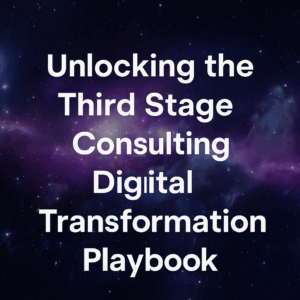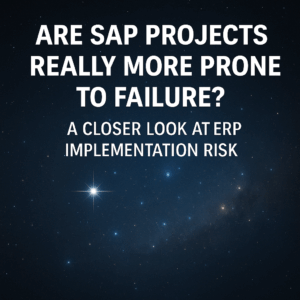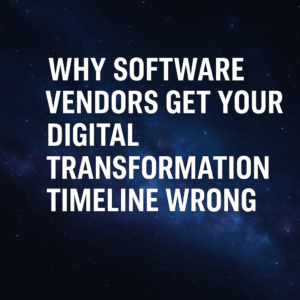Most ERP implementations and digital transformations are delayed and take longer than expected. This however does not need to be the case for you. Through our experience and research over the years, we found that a majority of implementations take longer than expected. The statistics we’ve seen range anywhere from 60 to 90% of projects take longer and it leads one to wonder why the projects are overdue. In this blog, I want to talk about the things that we see as root causes of why projects get delayed. It comes down to five simple things that you can do to ensure your project stays on track.
Table of Contents
ToggleRealistic Expectations
One of the early dominoes to fall in a delayed ERP implementation or digital transformation is unrealistic expectations. We thought we could implement the solution in 12 months, when in reality, it was always going to take 18 or 24 months, given our size and complexity, and level of resource commitment. What ends up happening, is sales reps from software vendors and system integrators oftentimes will underestimate severely what it’s going to take to make the project succeed.
The dynamics behind this are useful to understand and the reason why these estimates out front are so often underestimated is because they may not fully understand the complexity of your business and they may not have fully thought through or aligned the assumptions behind the overall implementation timeframe. These are some of the reasons why software vendors and sales reps will underestimate the number.
The other thing that happens or is in play in these types of situations is that the sales rep doesn’t necessarily have an incentive to be realistic, it might behoove them to underestimate and lowball, the amount of time and effort will be so that you’re more likely to commit to signing on the dotted line.
The reality is that most of the time when organizations take at face value, an implementation proposal from a system integrator, or system vendor, more often than not that implementation duration is underestimated. You want to make sure you augment the timeline and add a dose of reality to it. A lot of times that can be validating the assumptions behind the implementation duration.

Here, they are proposing something that’s typically focused on the software itself and the technology. We need to look at the entire breadbox and understand the entire duration, the entire scope in order to arrive at a realistic plan. But, whatever we do, we need to make sure we have a realistic plan, to begin with. This is ultimately one of the best ways we can avoid delay.
Clear Strategy and Internal Alignment
One of the root causes for delays on these sorts of projects is a lack of a clear strategy and or lack of executive alignment around that strategy. With this being one of the biggest headwinds that we face in ensuring that we finish on time, we know that we need to make sure that we’ve got an alignment on what it is our strategy is, and what this transformation means to the organization.
For example, a lot of times executives will say one of our goals for this project is to leverage out-of-the-box technology and minimize customization of the software. This is a great goal. There’s nothing wrong with that. But oftentimes, executives and the rest of the organization don’t understand what that means in terms of now we’ve got to force our business to change more to fit the technology rather than adjusting the technology to fit the business.
It all comes down to really having a simple understanding of what exactly it means in this example, to go with zero customization, and to use off-the-shelf capabilities. It comes with understanding what the tradeoffs are, that alone can really open your eyes to what exactly is this implementation going to look like. The key here is to recognize that we need to have a clear vision for this project and what we expect to get out of it.
We want to make sure we’re all fully aligned on this project before we get too far in. Otherwise, if we’re misaligned, that’s going to create delays later on.

Decisive Decision Making
When you look at all the activities in a project plan, all the different tasks that you would see in a Gantt chart or a Microsoft Project Plan for ERP, or digital transformation, you find that there are a lot of things that need to be done to design and build software. Most of this is in fact very predictable.
In order to define how we’re going to build the system and actually build it and test it, it’s fairly easy to predict how long that stuff is going to take. It’s sort of a black and white sort of activity. What I mean by that simply is, either the system works or it doesn’t. Where companies run into trouble and run into delays is typically around the decision-making that goes into what it’s going to take to build design and test the software.
When you’re dealing with any sort of ERP software, most of them are fairly flexible products and that’s going to require a certain amount of decision-making. The faster we can make those decisions, the faster the project is going to go. Where companies get into trouble is they don’t have a clear answer, or they can’t come to a clear conclusion on what they want their processes to look like, and that is not what we want. This ends up delaying the project.
If you can make as many of those decisions as possible before you really engage with your system integrator, that’s one of the better things you can do. You now get to speed things up and create a clear blueprint and roadmap for how the technology will be deployed, which will ultimately speed things up later. Either way, no matter how you approach it, just make sure you can make decisions quickly throughout the project.
Understand What Successful Transformations Require
The next thing you can do to avoid implementation delays is go back to the expectation setting again, and understand what it’s really going to take to make the transformation successful. Understand what sort of internal resources you’re going to need, what sort of competencies you’re going to need, how much you’re going to have to spend on identifying what your needs are, and your requirements, and putting project governance in place and managing organizational changes.
Everything that goes into a successful transformation needs to be taken into account and the better understanding you have going in with your eyes wide open, the more likely you are to have a realistic expectation for what the overall implementation is going to be. When we have realistic expectations on what it’s going to take to make this project successful, the less likely we are to realize delays and problems later on in the project.
Project Governance and Quality Assurance
If all else fails and if the first four things aren’t enough to help keep your project on track, you need some sort of stopgap to fall back on to ensure you have a safety net to catch any sort of delays, problems, or risks along the way.
One of the best ways to do that is to institute a third-party quality assurance and risk mitigation process that allows you to really have an objective and outside oversight in making sure that we identify risks before they become problems. Organizations and even their consultants don’t see the problems until they become painfully obvious and it’s too late to fix. In the end, you need someone who can come in and identify those risks early on, so you can proactively address them.

While most projects take more time than expected, they also cost more. Despite these facts, it doesn’t mean you have to suffer through the delays, it doesn’t mean that you need to be surprised by how long this is going to take or how much money it’s going to take. By simply following these five things, you’re going to be well on your way to making sure that your project is on time and on budget.
Resources
To learn more about this, I encourage you to download our 2020 ERP report. This will give you a lot more best practices into what we’ve seen other transformation teams and clients learn in some of the things that we’ve seen work very well for those organizations.
Knowing how to implement an ERP system using these five keys is one of the biggest decisions you will make regarding your transformation. No matter who you contract with, my team and I are available to be your impartial sounding board and digital transformation guide. If you’d like to discuss digital transformation and ERP implementation or other topics in more detail, please reach out to me directly. My inbox is always open.






